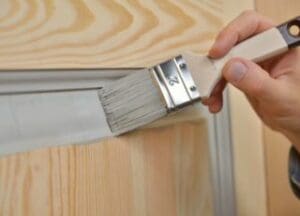Are you looking to paint your composite door?
Here's everything you need to know about painting them.
If you've recently bought a composite door, you'll probably be wondering how to best take care of it. If you've had wooden doors that required painting, treating, or sealing in the past you might think you'd need to do the same to your composite door.

However, one of the many benefits of composite doors is that they don't need to be painted.
This will save you plenty of time and money in the long term and make for carefree maintenance.
In this article, we'll look at why composite doors don't need to be painted.
We'll also check out how this will benefit you and how to paint a composite door if you choose to do so.
The reasons why composite doors don't need to be painted
Every composite door is made with a unique blend of wood and plastic polymers, and this material has many unique properties, meaning composite doors don't need to be painted, sealed, or treated.
This is a unique aspect of composite as a material. It's one of the main reasons composite doors outperform traditional timber doors and let you enjoy that new door look for much longer.
Let's take a look at the reasons why your composite door won't need to be painted:
UV-Resistance
One of the benefits of composite is that it's naturally resistant to UV rays. This means that your composite door is highly resistant to fading over time. So, there's no need to paint a composite door as it won't lose its colour.
Moreover, our range of composite doors is wrapped in CoolSkin technology rather than glass-reinforced plastic, providing them with another layer of protection against UV light and fading.
Your composite door colour is designed to last, so you won't need to worry about it fading over the years.
Rot-Resistance
The main reason why traditional wooden doors need to be painted, sealed, and treated is that timber absorbs a lot of water, so it leads to mould and rot developing, which results in the need for a replacement door.
The plastic content in a composite door means it's resistant to water absorption. This means rot and mould can't take hold within a composite door, so it never needs to be sealed, treated, or painted.
Scratch-Resistance
A heavily scratched front door isn't a good look. It can make the entrance to your house look tired and need repair.
Fortunately, composite front doors are very resistant to scratching. Your composite door is built to cope with everyday wear and tear, which is another reason why there's no need to paint a composite door.
Some scratches may be intentional if you're paint-stripping your doors, don't like the colour, and want a more natural wood look.
Longevity
Your composite door also has incredible longevity. As composite is resistant to fading and rotting, it will last much longer than other door materials such as wood.
The unique composition of a composite door means that it expands and contracts very little during high and low temperatures. This means that it won't warp throughout its lifespan.
Doors made only from wood need to be treated to make them more resistant to changes in temperature. A composite door is manufactured to withstand this, which makes treating or painting it unnecessary.
Amazing Colour Ranges
The colour of your front door is one of the first things guests see as they enter your house, so the door colour you choose should make a good first impression.
When you buy a new door, it arrives already coloured. So you won't need to worry about painting it in your desired colour.
Our fantastic range of composite door colours includes graphite, pearl grey, and moondust grey. We also offer a vast range of types and styles with different varieties of door furniture.
These include Edwardian front doors, Victorian doors, 1920s front doors, arched doors, Anglian doors, Georgian doors, cottage doors, and much more.
The benefits of not having to paint composite doors
The fact that composite door painting isn't necessary has several benefits.
Besides the fact that your front composite door, back door, or interior door will arrive pre-coloured with no need for a first coat of paint, there are many other advantages, too.
Low-maintenance
As your composite door doesn't need to be painted, you'll save much time on maintenance. Once it's fitted, you won't need to worry about its upkeep.
The only required maintenance is occasional cleaning, which is easy to do and isn't time-consuming.
Doors made entirely of timber require much maintenance and must be regularly painted. But your composite door is manufactured to be carefree, and no maintenance is needed to maintain its longevity and durability.
Eco-friendliness
The paints, sealants, and treatments used on traditional wooden doors often contain toxins harmful to the environment.
Over time, they're washed off by rainwater and can seep into the water table. This contributes to land and water pollution.
Composite doors don't require these chemicals, making them a more eco-friendly option.
Money-saving
Another benefit of not having to paint a composite door is that you'll save money over time. High-quality paint is expensive, and if you want your front door to look its best, cheap paint isn't an option.
As there's no need to paint a composite door, you won't need to worry about investing in expensive paints. If you dislike the colour, you can buy a new one, but it'll cost over £1,000 fully fitted in the UK.
Can you restore a composite door?
As we've mentioned, composite doors have fantastic longevity and durability. However, it's still possible that you may have caused damage to your door in some way.
This could include scrapes, bumps, or cracks that impact the door's surface. Rather than ordering replacement front doors, you might want to try restoring small areas of damage yourself.

The best way to do this is to use a touch-up pen to fill in any minor marks or scratches on the door.
It's possible to buy touch-up pens that match the colour codes of certain composite door manufacturers.
If you plan to use a touch-up pen, remember that if the colour doesn't match your door, it could harm its aesthetic value.
You can also plan a door bottom if the door has been distorted or warped to fit in the frame again.
Can composite doors be polished?
As well as there being no need to paint a composite door, there's also no need to polish it. The protective outer layer on our doors gives them a beautiful finish that doesn't require polishing.
The composition of this outer layer also means that it would be damaged by regular polish.
If you polish your composite door, use a specialist multi-surface restorer. However, these are expensive, and your front door will look great without being polished.
The best ways to clean a composite door
Composite doors require very little maintenance and will save you time and hassle.
But although they don't require painting, they need to be cleaned occasionally to keep them looking their best. Cleaning your door is also an excellent way to keep the colour looking fresh.
To clean your door, wipe it down using a sponge and warm, soapy water. If there are any glazed sections in the door, then wash them the same way. Once the door is clean, wipe it with a soft cloth to dry it.
You should only need to clean your composite door around once a month.
If you stain your door, you'll need to remove any stains using a specialist cleaning solution. If so, ensure you check the solution won't damage your door before you use it.
Check out our blog for more tips and advice on caring for your composite door.
What type of paint can be used on composite doors?
Although composite door painting isn't required, you may still choose to do so.
There's a debate on what paint is best to use, but it's generally agreed that oil-based enamel paints are the best choice.
When choosing the paint, you need to be very careful that it won't cause any damage to the surface of your composite door. Make sure that you avoid regular paints that are used for timber doors.
If you decide to paint your door, it means that you'll increase the needed maintenance as you'll need to re-paint it over the course of its lifespan, which is time-consuming and expensive.
How to paint a composite door
Although unnecessary, if you've decided to paint a composite door a new colour, there are several steps that you'll need to follow to make sure that it's done correctly:
Clean
Firstly, you'll need to thoroughly clean your door using sugar soap or warm, soapy water. This will remove any oil, grime, dirt, or residue on the door before you paint it.
Sand
You'll then need to spend some time sanding the door's surface so the paint adheres properly. Once you've filed it, you must wipe it down to remove any dust.
Paint
If the paint you're using needs a primer, then you'll apply this layer first. You'll then add one or two coats of paint to the door. A second coat can often make the job look more even and professional.
Spray painting a composite door is also an acceptable method of painting and will often be a quicker way of doing so.
Finish
Once the paint is applied, you must add a layer of beeswax or another product to protect the paint. This will also give it an attractive finish.
FAQs
Are composite doors more expensive than wooden ones?
Generally, composite doors are still more expensive than wooden ones in terms of upfront cost.
This is mainly because the manufacturing process for composite is labour-intensive. This increases the overall cost of the material.
However, composite materials require very little maintenance and rarely need to be replaced, so you'll save money in the long term.
Wood doors are much more expensive over time as they require regular maintenance and often need to be replaced.
How long do composite doors last?
On average, you can expect a composite door to last for around 30 years as they're made with a mixture of wood and plastic. This material gives composite doors a massive advantage over wood doors regarding lifespan.
This is another way composite doors save you time and money, as you don't need to worry about replacing them for a long time. Get the best composite door for your money using our door builder.
Are composite doors more eco-friendly than UPVC ones?
The wood and plastic used to manufacture composite doors are recycled materials. This makes them a very eco-friendly option. During the manufacturing process of UPVC doors, harmful chemicals can be released into the environment.
This isn't the case for the manufacturing of composite materials. The longevity of the composite also contributes to its eco-friendliness, as composite doors don't need to be replaced as often, making them a sustainable option.
Do you have a UPVC door you want to paint? Please read our guide to painting UPVC doors and windows.
Are composite doors secure?
Due to their natural robustness and durability, composite doors are very secure. Their sturdiness means they're incredibly hard to break, providing excellent security for your home.
Our range of doors comes with the additional security of ABS anti-snap, diamond-grade cylinders. Combined with the durability of composite, this delivers unbeatable protection.

Final thoughts
The unique composition of composite materials means no need to paint your composite door.
Your door will arrive pre-coloured with a natural finish that will compliment the aesthetics of your home.
The fact that composite is highly resistant to mould, fading, scratching, warping, and cracking also means that it doesn't require any added protection from paint.
Once it's installed, the only thing you'll need to do is clean it now and again.
As we've shown, it's possible to paint a composite door if you'd prefer, but this will increase the maintenance and ultimately cost you money over time.
Overall, it's best to leave your composite door as it is once it's fitted in your home. If you're not happy, though, look at getting a new one here:









